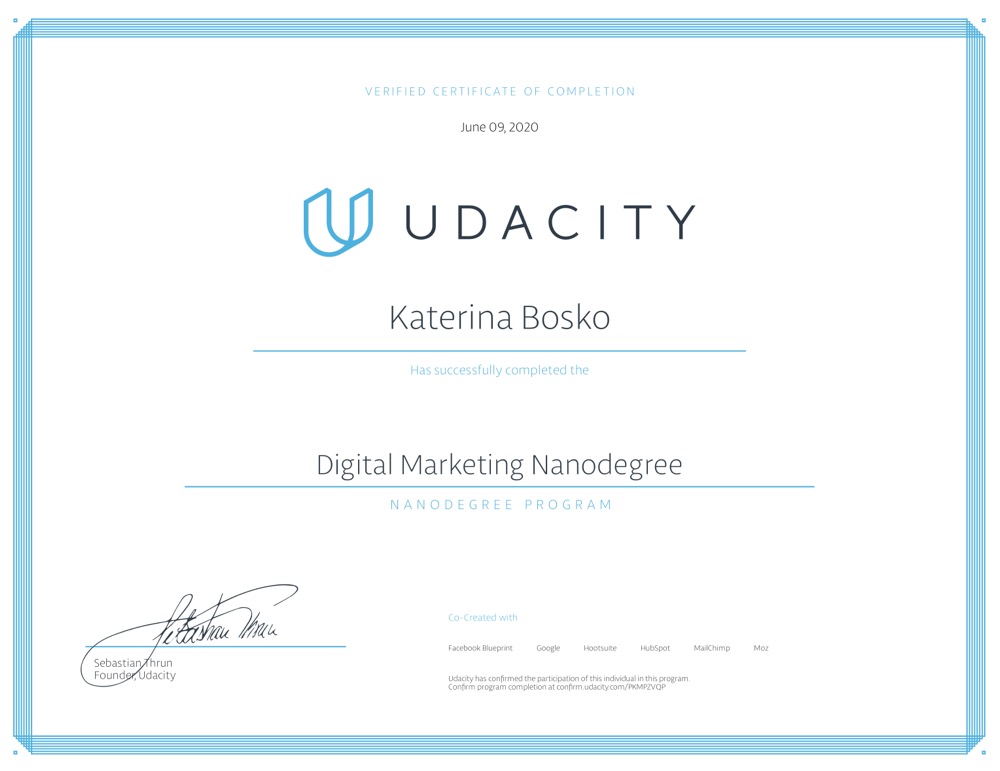Udacity Review: Digital Marketing Nanodegree

Udacity offered 1 month for free and I decided to enroll into Digital Marketing Nanodegree, mainly for two reasons.
First, I am interested in Data Science for Marketing and Product Analytics, so I thought expanding my knowledge into Digital Marketing would help me better understand marketing problems.
Second, I had previous experience with Udacity Nanodegrees (see my review of Data Science program here) and decided to challenge myself to graduate within a free month.
So given my motivation above, I will answer the following questions in this review:
- Is the Digital Marketing Nanodegree worth to pursue, especially when there are many free resources on the subject?
- How long does it take to complete the program?
Digital Marketing Nanodegree: Overview
Tools: Google Analytics, Google AdWords, Facebook Ad Manager, Google’s PageSpeed, SEMrush, MOZ, MailChimp
The program is structured around core digital marketing sectors that provide good foundations into digital marketing landscape:
- Content Marketing
- Social Media Marketing
- Social Media Advertising
- Search Engine Optimization
- Search Engine Marketing
- Display Advertising
- Email Marketing
- Google Analytics
From the start you have to choose which marketing challenge you want to pursue:
- B2C: Digital Marketing Nanodegree (DMND) Program
- B2B: Enterprise’s DMND Corporate Training
- marketing for your own company
Once chosen, you will work through the program to create a marketing strategy for your “product”. This means that your projects will be around this marketing challenge. So if you chose B2C option, for instance, you will create a Target Persona, generate leads with Facebook campaign, create email workflow for DMND only.
There are 10 projects to complete:
- Prepare to Market: develop a target persona, formulate marketing objective and KPI
- Market your Content: write a blog post and promote it via social posts
- Run a Facebook Ad Campaign Part 1: create a campaign and run it
- Run a Facebook Ad Campaign Part 2: analyze results and provide recommendations
- Conduct a SEO Audit: recommend a target keyword list and how to optimize for ranking in search engine results
- Run an AdWords Campaign Part 1: create a campaign & run it
- Run an AdWords Campaign Part 2: analyze results and provide recommendations
- Evaluate a Display Campaign: analyze results and provide recommendations
- Market with Email: develop email plan, create email with MailChimp and evaluate the results
- Create Digital Marketing Portfolio: develop a marketing budget and get all other projects together in one place
For both campaigns you actually run you get a budget - $100 for Facebook and ~$50 for Google AdWords. So you spend real money on advertising like on a job.
Pros: 360-degree overview + hands-on experience in running campaigns
DMND lives up to its promise - you learn 360-degree of Digital Marketing landscape, which I think not every program out there does. It is good introductory course for those who would like to decide which career path in digital marketing to take, and as it turned out there are plenty! From more creative jobs like content Strategist or Email Marketing Manager to more technical like SEO Analyst or Marketing Analyst.
What I liked the most is that DMND provides a good overview over the job market - job descriptions with common titles, average base salary, skills for the job and typical responsibilities from 8 different digital marketing sectors. They also recorded videos with professionals that explain what their day-to-day work looks like.
And probably the most valuable skill that this program teaches you is running actual campaigns on Facebook and Google AdWords. For this, you really need to have a business account. Unless you run a small business or already working in digital marketing, you won’t be able to get this experience. I also liked that I could see other students’ campaigns and learned a lot from analyzing their approaches and what works best. So you really benefit from getting an access to Udacity accounts on Facebook Ads Manager and Google AdWords. They also give you free access for 30 days to SEMrush, which has great tools for SEO and competitive research.
So, I think Digital Marketing is a good starting point and has many advantages over other programs/courses out there. You learn by doing, not only reading.
Cons: not difficult but extensive
I would grade the program as not very difficult. However, it has 10 different projects that you need to complete in order to graduate. As a result, I underestimated time needed and did not finish in 1 month as planned (I also had some other projects I worked on alongside studying). Despite this, I decided to prolong the program for another month since I felt that I learned a lot (and was grateful for what I learned), accomplished a lot and did not want to lose that progress.
So, 1,5 months on 1.5x listening speed is realistic estimate for those who took MOOCs before. I find DMND on monthly basis still expensive - $400. But there is a trick: if you unsubscribe and give program cost as a reason, they will try to win your back and give a discount.
Final advice to those who are more into Data Analytics/ Data Science like me and consider taking Digital Marketing Nanodegree for the same reason as mine - don’t expect much. The program is not technical and doesn’t teach Marketing for Machine Learning tasks. That said, I do understand the key Marketing metrics better and how Marketing functions after completing the program. But you probably can learn this on a job as well. As I am in career transition and don’t have formal business education, I think completing a Digital Marketing Nanodegree is a nice add-on to my skills and knowledge.


Leave a comment